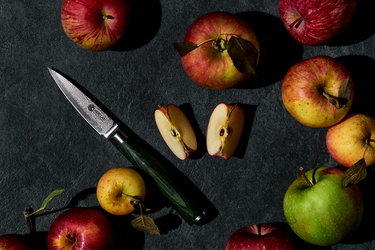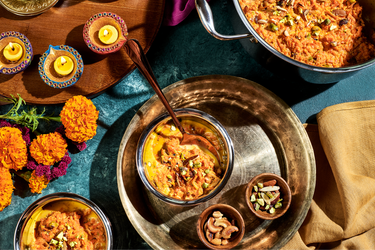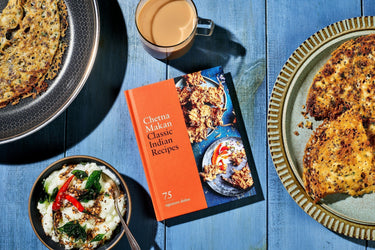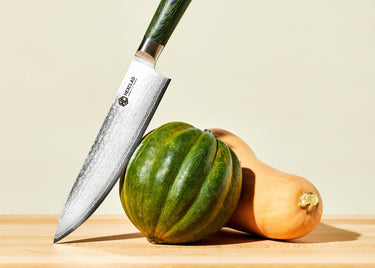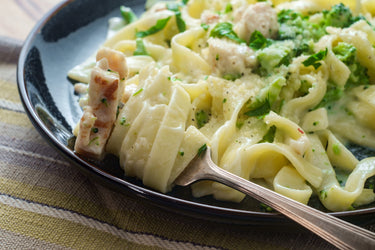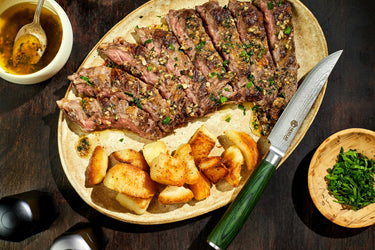German vs. Japanese Knives: A Comparison Guide
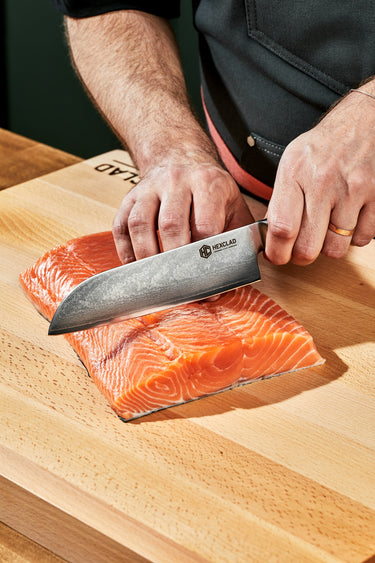
Different knives have different purposes, and two that you may have heard of are German and Japanese knives. But what are the key features and differences of these knives? Should you seek out one over the other?
Let’s find out.
What Are the Key Features of Japanese and German Knives?
Japanese and German knives are both popular types of knives found on kitchen counters far and wide. The difference between the two lies largely in the hardness of their steel and the angle of their edge.
Which Knife Has a Thicker Edge?
The edge of a knife’s blade defines its sharpness and is the component of the knife responsible for the actual cutting. Different ingredients respond better to different types of edges, so it’s important to invest in knives that will fit your specific cutting needs. Both thick and thin edges provide different benefits.
As for which knife edge is thicker — German knives take the cake on this one. German knives tend to be heavier, and their thickness allows you to work through tough veggies, thick cuts of meats, or even bones with relative ease.
Japanese knives, meanwhile, are lighter and thinner, creating a sharper edge ideal for precise cutting such as deveining shrimp, deseeding, and working with soft and delicate fish or fleshy fruits.
If your goal is slicing smoothly through juicy fruits or cutting meat off the bone, a thin and sharp Japanese knife will be your best friend. These lightweight knives are easy to handle and offer unmatched precision and control.
Which Knife Is Harder?
The hardness of a knife is measured by the Rockwell scale. Harder metals rank higher up on the scale.
When comparing Japanese and German knives, the type of steel used to construct Japanese knives is harder, scoring a higher number on the Rockwell scale.
So, what exactly does this mean?
Harder knives tend to be more brittle and more prone to cracking under intense pressure. But, the benefit is that their hardness makes them sharper — and capable of retaining their sharpness for longer than softer steel blades.
Sharpness is key when using a knife for delicate cuts and precise handiwork. And the good news is that sharper knives require less force to cut through foods, meaning that the risk of chipping the knife is less likely as you are applying less pressure with a sharp knife.
This means that the ability of hard Japanese blades to retain their sharpness can more than make up for any brittleness that comes with harder steel.
And, if you’re wondering what makes Japanese steel harder — it all comes down to the chemical elements that create the metal’s alloy.
Remember the periodic table of elements you had to memorize in chemistry class? Steel contains two of those elements: iron and carbon. Carbon content is what makes steel harder, and so the more carbon included, the harder the steel is.
Japanese knives are made with higher carbon steel than German knives, and that carbon helps create a longer-lasting sharpness along the cutting edge.
Which Knife Needs To Be Sharpened More Often?
The hardness of Japanese steel gives it an edge over the competition (pun intended). But, all jokes aside, Japanese blades are quite literally sharper than German blades and are better at retaining that sharpness, too.
Since German steel contains less carbon than Japanese steel, German knives typically require sharpening more often than their high-carbon counterparts.
This is because the steel of German knives is softer, so the blade can wear down more easily. To ensure your German knives are slicing as effectively and safely as possible, it is important to sharpen them regularly and as needed, which is typically once every few months, depending on how often they are used.
The wideness of the blade angle also plays a role in how sharp the knife is overall. Sharper knives have smaller angles, as the narrow cutting path means the knife can cut smoothly without damaging your ingredients.
German knives tend to have angles around 17.5 degrees, while the angle of the blade on Japanese knives is closer to 10 to 15 degrees, creating a sharper blade that can make more precise and controlled cuts.
A sharper knife provides more control. Dull knives require more force to cut through ingredients, which increases the risk of the knife slipping and potentially nicking your finger in the process. Sharp knives are safer and more convenient to use.
Whether you are using Japanese or German knives, it is important to sharpen them whenever they become noticeably duller and require more force to cut through your food. However, you’ll likely find that Japanese knives don’t begin to dull as quickly, providing optimal edge retention compared to other types of knives you use as often.
Which Knife Is More Lightweight?
Because carbon is lighter than iron, Japanese knives are more lightweight than German knives. The lightness of Japanese knives makes them easy to use and handle, providing more control for delicate cutting and artistic displays.
While heavier knives provide more leverage that can come in handy when slicing through thick ingredients, lighter knives can make quick and impressive work of soft or slick foods.
Lightweight Japanese knives provide the perfect tool for coring, deveining, deboning, and deseeding.
What Are the Essential Japanese Knife Styles?
Japanese knives are highly esteemed and deeply rooted in a tradition of greatness.
See, the craftsmanship associated with Japanese kitchen knives dates back to the 700s. The knifemaking process was born out of the same technology and techniques used to create Samurai swords. It’s no wonder Japanese knives are so highly regarded for their precision, quality, and elegance, huh?
Some traditional Japanese knives you’ll find include the santoku knife, the gyuto knife, the nakiri knife, and the sujihiki knife. While all of these Japanese knives have their purpose, the two most common and versatile styles are the santoku and the gyuto knives.
The Santoku Knife
The Santoku knife is a multipurpose kitchen tool that deftly moves among various cutting tasks. Translating to “three virtues,” the santoku was named for its ability to move elegantly and efficiently through meat, fish, and produce.
The Santoku knife has a long blade that tapers to a low point. Known as a sheep’s foot design, this shape can create quick and precise cuts thanks to its sharp edge and low point.
Another defining quality of the Santoku knife is the indentations running along the blade's edge. Unlike the versatile chef’s knife, the Santoku knife contains dimples or scallops along the length of its straight edge to keep food from sticking to the knife as you cut.
The scallops are particularly useful when working with clingy fruits and veggies such as garlic or potatoes. The wide blade of the santoku can also scoop and transport ingredients easily — and without dirtying extra cutlery (always a win in our book).
Whether you’re cutting fish, dicing carrots, mincing onions, or slicing thin meats, the sharp and sturdy santoku knife can get the job done safely and effectively.
The Gyuto Knife
The Gyuto is the knight in shining armor (or, should we say, knife in shining armor) of Japanese knife wear. Gyuto translates to “cow sword,” so you know this knife means business.
While originally designed to slice beef and similar meats, the Gyuto is no one trick pony. The sharp and sleek edge of the Gyuto knife is ideal for slicing, dicing, chopping, and mincing all sorts of food that find their way onto your cutting board.
The Gyuto knife has a pointed tip and super fine, hard-steel edge that provides optimal balance and stability when rocking the knife back and forth on the cutting board. Mincing garlic has never looked so good.
What Are the Essential German Knife Styles?
While Japanese knives are revered for their sleekness and precision, German kitchen knives offer thick and solid blades that can tackle the toughest of foods. The most well-known German knife is the German Chef’s Knife.
What Makes the German Chef’s Knife Unique?
A chef’s knife is one of the main tools in every chef and home cook's arsenal, and it’s clear why.
Also known as a cooking knife, the chef’s knife has a fine point that can pierce and cut soft foods such as fleshy fruits and herbs. The thicker heel of the blade is a pro at breaking through thick skins and hardy foods such as potatoes, meats, and firm veggies.
A German Chef’s knife is a particularly unique tool due to the softness of the steel. German steel typically falls at around 56 to 58 on the Rockwell scale, placing them lower than the Japanese knives, which are made of harder and lighter steel.
The softer steel used to construct German chef knives and other western-style knives may dull quicker but is also less brittle and less likely to break.
The stainless steel that German knives are forged from typically has a high chromium content, which helps lower the risk of chipping or rusting. The chromium layer provides a protective barrier, and the softness provides more flexibility to reduce breakage.
German chef knives typically have a wide and curved blade. While curved blades offer less precision than straighter edges, they can help provide better balance and stability for rocking the knife back and forth on the cutting board — a technique commonly used for mincing and chopping.
The heft of the thick German blade can also provide support when cutting through thick and hard foods. With a wide heel, curved blade, thick edge, and softer steel, the German chef’s knife can power through a wide range of tasks in the kitchen without breaking a sweat.
What’s the Bottom Line?
When it comes to steel knives, Japanese and German knives are some of the best in the business. Both styles provide their own set of benefits.
German knives are thicker and heavier to provide added strength and durability for your heavy-duty chopping, while Japanese knives are made of carbon-rich steel for a lightweight blade and razor-sharp edge that offer edge retention and ultimate control and precision.
We love the ease of use the lightweight Japanese knives can offer, along with the delicate and even cutting that the harder and thinner blades of Japanese knives are capable of producing.
This is why we use only high-quality Japanese Damascus steel to forge our knives here at HexClad.
Our Essential Six Piece Japanese Knife Set offers versatility in the form of six powerful and precise knives: a chef’s knife, bread knife, santoku knife, utility knife, and paring knife, plus a honing rod to keep your tools sharp.
With a 60 Rockwell rating, the hard blade and sharp edge of our knives can effortlessly slice through the ingredients needed for all of your favorite meals. The full-tang construction of our knives provides superior weight distribution and balance for ease of use.
Prep work shouldn’t become a high-risk workout.
The layers of Damascus steel create an awe-inspiring wave pattern along the blade, while the handles are crafted with striking forest green pakkawood to complement any kitchen.
These sharp, sleek, and sturdy kitchen workhorses don’t just make prep work look good. They ensure it feels good, too.
Sources:
Rockwell Hardness - an Overview | ScienceDirect Topics
High Carbon Steel - Materials Library | Institute of Making.
Be Careful with Kitchen Knives | Nationwide Children’s Hospital
